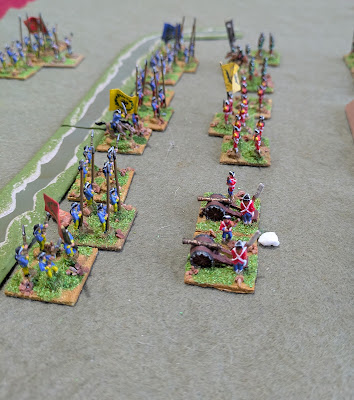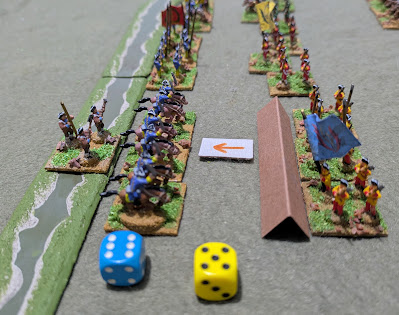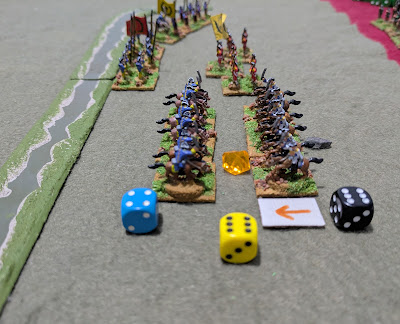I spent Sunday morning mowing the lawn (which still needs to be done, even in the winter), and measuring up the garage for some much-needed shelving. And then part of the afternoon was spent helping my daughter put up a curtain rail. So a fairly busy day. But I found some time in the afternoon to set up, play and record a couple of games of 'Dominion of Marlborough and Peter The Great'. Great rules but, my god that title is cumbersome!
Up until now I've fiddled around with the WSS scenarios, but this afternoon I switched my attention to some battles from the Great Northern War. Rather than dive into the classic ones with the Swedes fighting the Russians, I played the two scenarios in the book which pitted Charles XII against Augustus II, Elector of Saxony and self-proclaimed King of Poland. This conflict would drag on for nearly six years, during which time Russia, who had been decisively defeated by the Swedes at Narva in 1700, rebuilt their army. That led, in time, to the Swedish defeat at Poltava and the effective end of their empire.
However that's a way off. For the first battle we find Charles XII facing a strong Saxon-Russian army entrenched on the opposite side of the wide River Duna, near Riga on 19th July 1701. Being Charles XII, he attacked.
The Swedes slipped part of their army across the river during the night, exploiting the fact that the Saxons defences were a couple of hundred metres back from the shore. By the time the defenders realised what was happening the Swedes had a toehold on the Saxon side of the river.
The battle starts there.
The Swedes (left) have three unit of Elite Ga Pa Infantry in their front line. Their reserves consist of two more units of Ga Pa Infantry and one of Sabres, all of which are Unreliable, reflecting that they have to force a crossing of the river by either boat or pontoon bridge. I used my new pioneer bases to mark the unreliable units.
The Saxon front line consists of some Unreliable Artillery (a lot of Artillery is classed as Unreliable in these rules, since its battlefield capabilities are a bit hot or miss), plus some Saxon line.
You'll notice that the infantry have their centre base advanced a little. This is because defending foot that starts the game in the front line enjoys an advantage against certain troop types, representing them being in good initial positions.
The Swedish reserve foot, showing the pioneers to the fore.
The main battle line.
Turn 1 - Swedish
The Swedes attacked on their right flank against the Unreliable Artillery here. It proved to be ... unreliable, and was removed. The Saxons moved up some Russian pike-armed infantry from the reserve.
Turn 1 - Saxon
In the centre the Saxon Line threw back the first wave of Swedish infantry.
(If you are wondering about the paraphernalia, the yellow die shows the turn number, the arrow shows which side is 'attacking', the blue dice shows the Swedish combat roll and the black die that of the Saxons. I roll both dice simultaneously even if one side gets to roll first. In this example that black 6 for the Saxons destroys he Swedish GaPa foot before their 6 - also a kill - takes effect. The orange blob shows which unit is destroyed.)
Turn 2 - Swedish
The Swedes pressed forward on the right and the Russian pikemen were cut down to a man (true story - there's a memorial to them). This brought the Swedes up against the main Saxon defences.
Turn 2 - Saxons
The Saxons activated in the centre where Swedish reserve infantry was attempting to cross the river. It failed to cross. Would the next wave make it?
Both sides attempted to rally lost troops at this stage. The Swedes rallied one of their Elite Ga Pa Infantry, whilst the Saxons tried to rally the Russian Pikemen, unaware that they were all dead. You don't rally back from all dead.
Turn 3 - Swedish
The Swedish left flank pushed forward, but the fighting was inconclusive.
Turn 3 - Saxon
The Saxons centre tried to push back the next wave of Swedish foot as they crossed the river, but failed to stop them getting ashore.
A fierce musketry duel ensued, but neither side gave ground.
Turn 4 - Swedish
On their left the Swedes charged the Saxons but were cut down and driven back into the river in disarray. But the rallied at the last moment.
(They didn't rally. In game terms the unit was lost. But the reserve unit that replaced them was the rallied Ga Pa Infantry and is exactly the same type of unit, so we'll assume the original unit rallied because it makes for a better narrative).
Turn 4 - Saxon
The troops in the Saxon redoubts fired on the advancing Swedes, who were forced to retreat, all momentum having gone out of their attack. If their cavalry could be brought up in support all might not be lost on that flank. But that depended on the building of a pontoon bridge.
Would the cavalry get across?
Turn 5 - Swedish
In the centre the Swedish foot failed to make any headway against the Saxons. All of their units were committed to the fight now; the Swedes had no reserves left.
Turn 5 - Saxon
The Saxons activated on their left as the troops in their defences fired on the approaching pontoon bridge. But the Swedes toiled away and the bridge was built. The cavalry streamed across!
Forming up they charged the Saxon entrenchments, and routed the defenders. The Saxons now hoped for their cavalry to come and save the day.
Turn 6 - Swedish
Desperate fighting on the Swedish left saw the Saxons there collapse. And there were no Saxon reserves.
The Swedes could now turn the Saxon right.
Turn 6 - Saxon
The Saxon cavalry force arrived, and charged the Swedes. Both sides shattered each other.
This left the Saxons with only their centre. The Swedes had won the day!
Thing started to look a bit desperate for the Swedes in the middle of the game when they had to rely on their unreliable reinforcements, but their boats and engineers saved the day, getting the troops over the river in the nick of time. The Saxons had nothing to counter them.
So an historical result for that battle. Would it be the same for the next one?
The second scenario in the rules is Klisow, fought on 9th July 1702. Charles XII had spent a year advancing into Poland in pursuits of Augustus II. At Klisow he faced a Saxon army awaiting reinforcements from their Polish allies. Hoping to attack before the allies arrived they found their left flank being attacked by Polish cavalry.
I set this up with a little bit of scenery, just to make the photos look nice. The attacking Swedes are on the left, the Saxons on the right in the centre and left sectors and the Poles (played by my Nottoman cavalry) are on the white horses in the distance.
The Swedes only have four units in this battle, but they are all either elite or determined. The Polish cavalry is determined but the reserve Polish cavalry is Unreliable (on the day the Poles quit the field after an initial setback - their alliance with the Saxons was fairly shaky).
Turn 1 - Swedish
The Swedish right, led by Charles XII himself attacked the Saxon cavalry before them, but the fighting was indecisive.
Turn 1 - Saxon
The Swedish attack in the centre was stopped dead by disciplined Saxon musketry. The Swedes committed their only reserve (more cavalry).
Turn 2 - Swedish
The Swedish left-flank advanced against the Polish cavalry, but made no headway against them.
Interlude: a shot of the battle so far, despite little actually having happened.
Turn 2 - Saxon
In the centre the line engaged the attacking Swedish cavalry, but were ridden down. However there's always more Saxon line to move up from the reserve.
At this point the Swedes tried to rally their lost infantry, but failed.
Turn 3 - Swedish
They activated on the left-flank where the Polish cavalry (led by winged hussars, in what would be their last battle) rode them down. The Swedes had no reserve.
Turn 3 - Saxon
The Polish cavalry swept into the Swedish centre and routed that as well.
A total disaster for Charles XII, left only with his cavalry! And a stunning victory for the Saxons, won almost entirely by their Polish allies.
To be fair I've played both of these scenarios a few times now and the honours have been about even. With small numbers of elite troops the Swedes can be prone to death by randomness (an elite unit is expensive but no harder to kill by an enemy who rolls first than one that isn't), but if it all comes together their troops steam-roller the opposition. Historically they did that in most of their battles. In Dominion the other side gets more of a look-in.






























Great battle reports and Good looking games. Druna was a nail biter. I have had some pretty one sided games with various editions of these rules as well, but not too often, and the games are quick so one doesn't feel disappointed.
ReplyDeleteA number of the GNW battles have small elite Swedish armies against enemies with two or more unreliable units. A lot of it swings on whether the unreliable troops fail their test. If they do, then the Swedes get the edge. If they don't then the Swedes are really up against it.
DeleteI haven't tried Narva yet, but that is four Swedish units against six Russian, but four of teh Russian units are unreliable. They are also in defences, so if a couple of them pass it's going to be a bad day for the boys from Stockholm.
Great stuff, I very much enjoyed the account of the river crossing battle. I also roll both sides dice simultaneously, it just seems a lot more work to roll them sequentially. Odd that.
ReplyDeleteA couple of nice reports, there, Kaptain. Gonna have to try the Dominion rules (I have ‘Spear’ and ‘Frederick the Great’). Are you tempted to run another campaign with them?
ReplyDeleteI need to work out an army generator for either the GNW or WSS. But I have an idea for a mapless campaign system which would work for either (but, conceptually, feels better for the WSS).
Delete